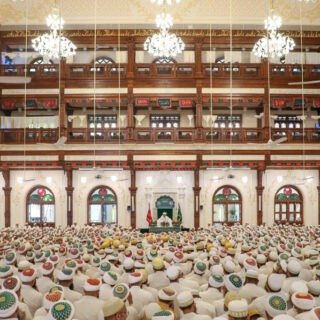Shibaam is heaven on earth. It is the highest peak of Haraaz rising 9000 feet above sea level. Barren beauty punctuated by green terraces stretches as far as the eye can see. The military fort stands mighty, enveloped in a mist of white fog. The edge of the mountain looks out onto a dizzying panorama of Haraaz, and neighboring cities, all the way to the Red Sea. The qabr mubarak of Syedna Idris ImaduddinRA lies here; it is encircled by mumineen who have come for ziyarat from far and wide.
The hike up the mountain is an adventure in itself. A caravan of four-wheelers winding up through rocky terrain. Red and white uqals trailing in the wind, as several Yemenis cling to the jeeps. Several other mumineen are climbing up on foot. As Aqa Maula’sTUS jeep passes by, the drums beat to the familiar Yemeni tune…
The life and times of the Duat in Yemen, especially Syedna Idris ImaduddinRA, the 19th Dai al Mutlaq, seem almost tangible up here. Yemen was fraught by tribal conflicts; Syedna Idris’sRA father, Syedna HasanRA captured the fortress of Shibaam after seven months of fighting. The food stock was exhausted, and the army began to eat animal skin, but SyednaRA remained determined till Shibaam was captured. One month later Syedna IdrisRA was born; mumineen were jubilant and offered tehniyaat of both occasions together, the capture and the birth.
Like his father, Syedna Idris ImaduddinRA was known for his strength and prowess on the battle-field. He fought battles in thunder and storm. His era was full of hardship but his forbearance gave strength to mumineen. In the last twenty years of his life, SyednaRA made Shibaam his permanent abode: not only for its strategic advantage, but also for the tranquility and solitude it offered.
Syedna IdrisRA was the fount of knowledge, his name is derived form the Arabic root “dars” which means study. Sitting by the birkat (pond), that we still see here and drink from, he composed seven volumes of ‘Uyun ul akhbar’. These volumes cover several hundred years of dawat’s history spanning three continents, from the time of Rasulullah’sSA predecessors to the period of satr. He penned other books of history and haqiqat. SyednaRA also composed verses in the praise of the forefathers of RasulullahSAand in the risa of Imam HusainAS which Aqa MaulaTUS often recites beside his qabr mubarak.
SyednaRA had predicated that the seat of Dawat would be transferred from Yemen to India. SyednaRA tested the conviction of mumineen in India by giving raza of namaaz to an ordinary bhishty (water carrier). All the Hudud in India accepted their Dai’s command, and prayed namaaz behind the bhishty. He then tested the ikhlaas of mumineen in Yemen; they failed to live up to his expectations. SyednaRA warned them that the seat of dawat would be taken away from Yemen.
Syedna IdrisRA reigned as Dai al Mutlaq for 40 years. He passed away on the 19th of Zilqada 872 H. Aqa MaulaTUS is recently building his masjid and mausoleum in Shibaam. His qabr mubarak on the highest mountain of Yemen bears testimony to his lofty status. Indeed the a’yat extolling Nabi Idris rings true in praise of Dai Idris ImaduddinRA: We have elevated him to an exalted position. His enduring legacy remains with us in his books on the comprehensive history of dawat and in the person of Aqa MaulaTUS.








